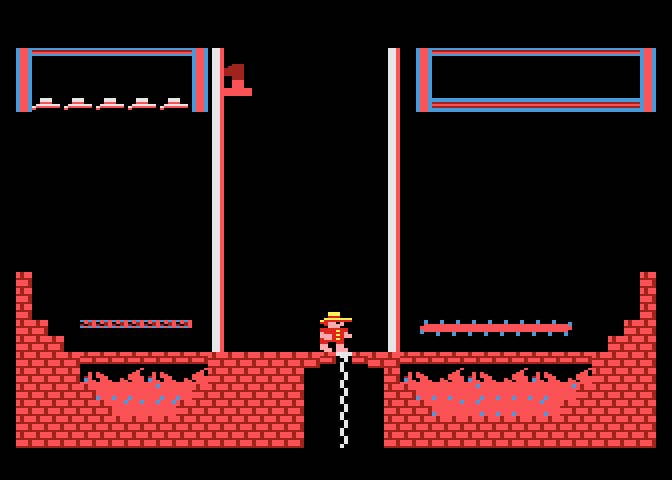Montezuma's Revenge, an Atari Quest to Make Adventure Proud
By borrowing from Atari's action RPG, Utopia created a platformer classic.
This article first appeared on USgamer, a partner publication of VG247. Some content, such as this article, has been migrated to VG247 for posterity after USgamer's closure - but it has not been edited or further vetted by the VG247 team.
Walk around. Find a colored door. Walk around some more. Find a key of the same color. Walk back to the colored door. Open it with the key. Repeat ad nauseum.
In the wake of DOOM's success in the '90s, key hunts quickly became one of gaming's most tiresome clichés. But at some point, even the hoariest cliché must have felt fresh and original -- yes, even searching for colored keys.
That point, as it turns out, came approximately a decade before DOOM, way back in 1984, amidst the doldrums of the U.S. gaming industry's post-Atari-crash days. In an era where video games often consisted of single-screen designs and rudimentary challenges, the need to traverse an interconnected maze was a bit mind-blowing. It was enough to make bare-bones role-playing games like Wizardry and Ultima into massive hits; when those concepts began to trickle their way into platform action games, the genre changed forever.

It's a shame that this revolution didn't really begin until the U.S. games industry had bottomed out. Impressive American creations like Pitfall II and H.E.R.O. didn't develop nearly the sort of fanbase that their contemporary Jet Set Willy acquired over in the UK, where the games industry was thriving rather than cratering. So, too, did Utopia's Atari 800 platform adventure Montezuma's Revenge go relatively under the radar.
More's the pity, because of all the exploratory platformers that debuted around the world in 1984, Montezuma's Revenge arguably had the most sensibly and thoroughly realized game world to explore. The entirety of the adventure transpired within the walls of a nine-level Mesoamerican pyramid, with the player entering from the peak and descending to the base level where, it was rumored, Montezuma himself awaited.

The game bore a lot of similarities to other platformers of the time, most notably Tim Martin's Spelunker and the Donkey Kong series, but more than anything else Montezuma's Revenge called back to Atari's Adventure for Atari 2600. In both games, much of the journey involved backtracking through a labyrinth of screens in search of properly colored keys to unlock doors that led further into the maze. And, much like the the brave square protagonist of Adventure, Panama Joe could collect limited-use weapons and tools to aid him in his descent into the deadly ziggurat.
Despite the spiritual connections to Adventure, Montezuma's Revenge designer Robert Jaeger didn't look to RPGs for play inspiration; his game made use the of the full vocabulary of platformers. Joe did the usual running and jumping; he could climb chains like Donkey Kong Jr.; he battled the directional tyranny of conveyer belts; he evaded all manner of creepy-crawly monsters; he made mad timed dashes to avoid plummeting into flames when disappearing platforms vanished beneath his feet; and he died pathetically if he fell from too great a height. There's even speculation based on an early prototype of the game that the mystical amulet, an item which destroyed enemies, was originally designed to look and work like the hammers in Donkey Kong.
In other words, Monezuma's Revenge brought together just about every idea that had ever appeared in a platformer to date, then mixed in some RPG influences by way of Adventure. It was quite possibly the most elaborate and complex platformer of its time, and you can find echoes of its design even today in indie titles like Spelunky. Sadly, the Atari crash took its toll on this game like so many others; Parker Bros. ended up scuttling plans for an Atari 2600 version of the game, dooming it to relative obscurity on a handful of computer platforms, which were still coming into their own in 1984. (Oddly enough, it eventually made its way to Sega Master System, of all things).
While Montezuma's Revenge may not get the love it deserves these days, it was an impressive leap forward for a budding genre. Next time you slice your way through a latter-day Castlevania game or check to see the progress on La-Mulana 2's Kickstarter campaign, take a moment to say a silent "thank you" to the game that paved their way by borrowing the best of two genres and turning them into something greater than the sum of those parts.









